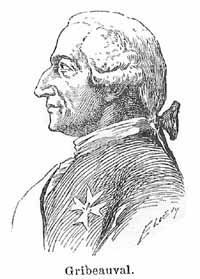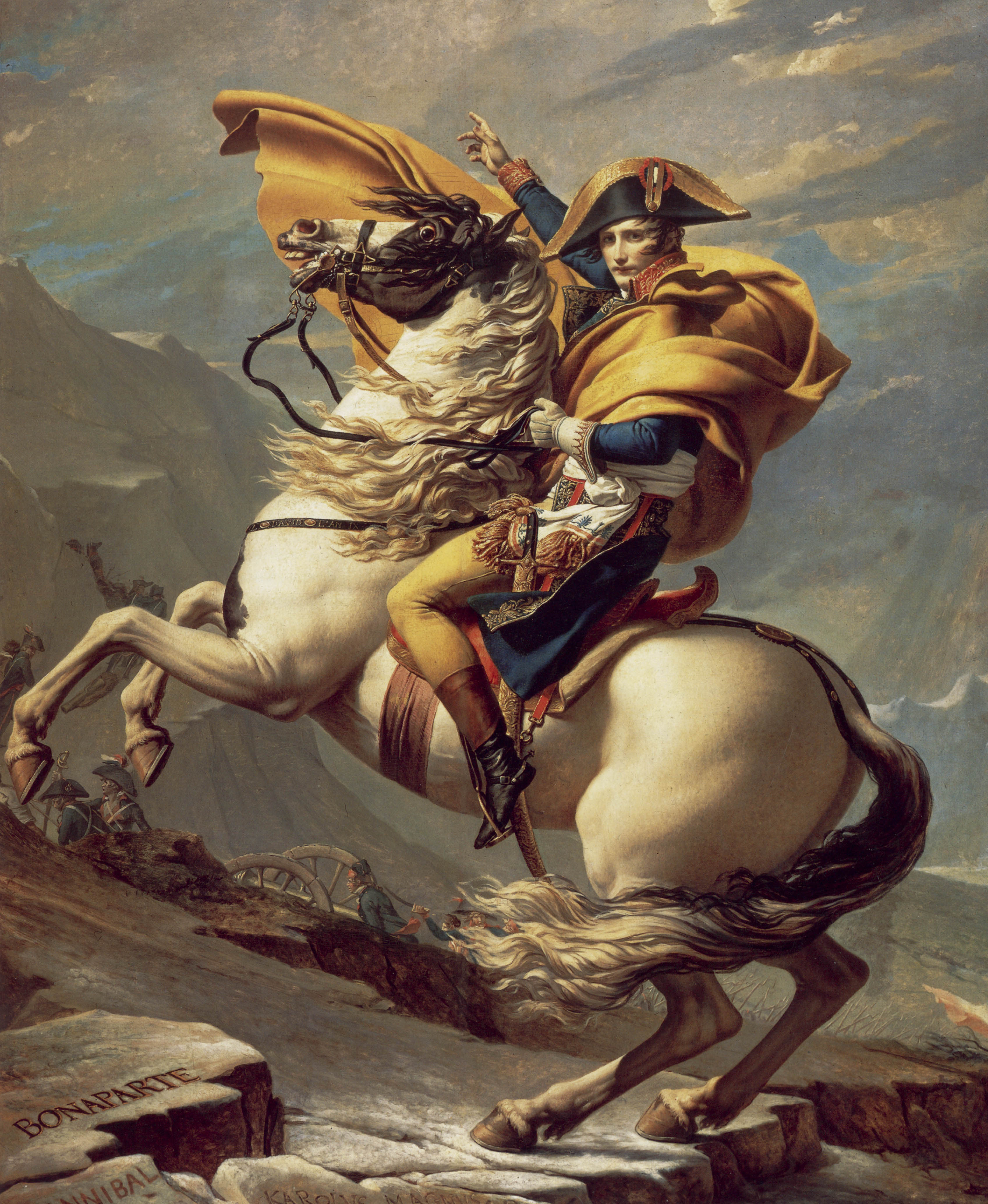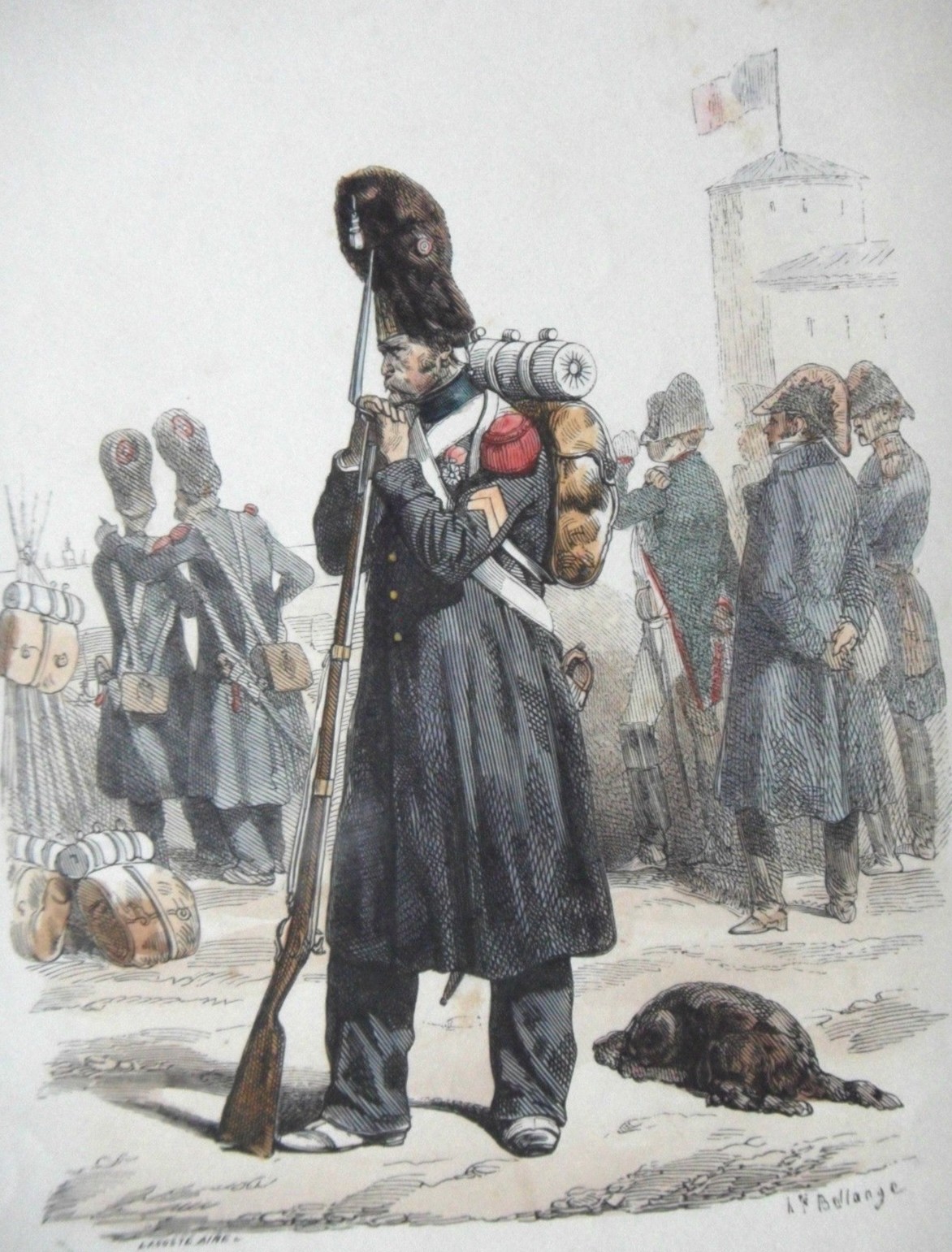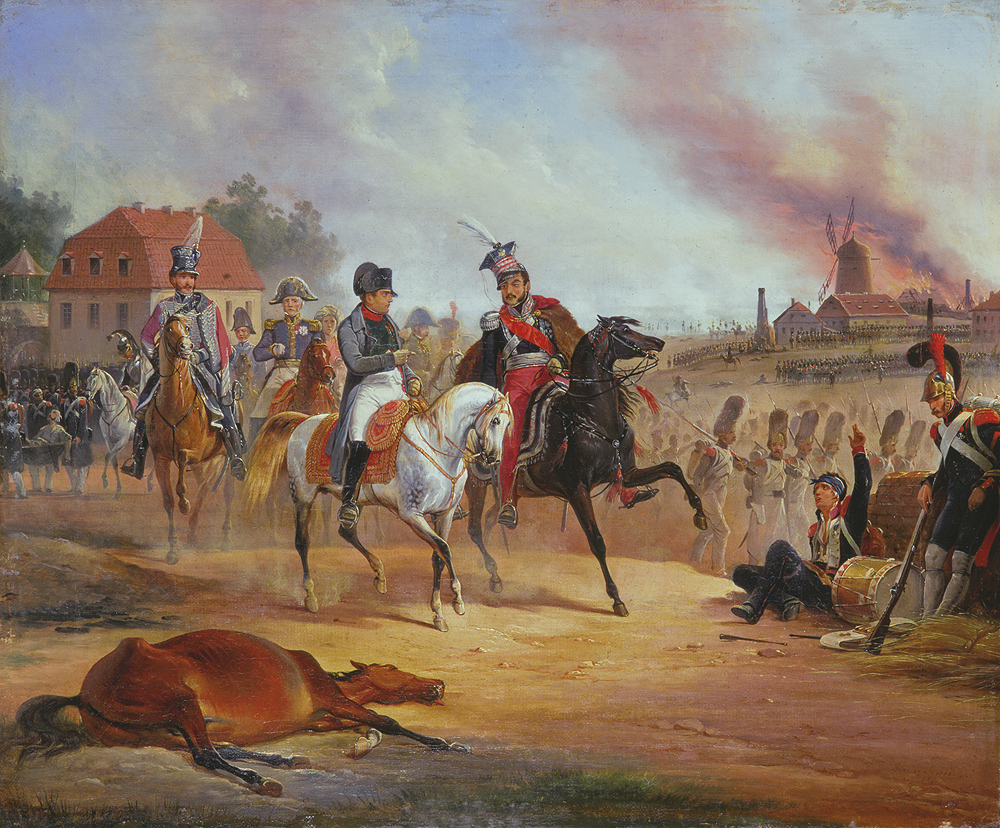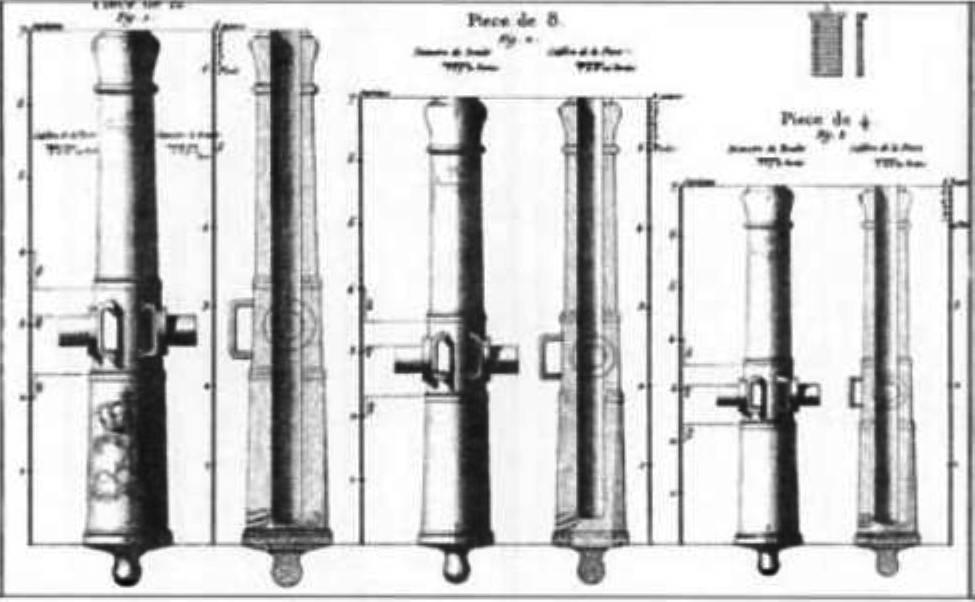|
Canon De 8 Gribeauval
The Canon de 8 Gribeauval or 8-pounder was a French cannon and part of the Gribeauval system developed by Jean Baptiste Vaquette de Gribeauval. The Old French pound (french: livre) was 1.07916 English pounds, making the weight of shot about 8.633 English pounds (or 8 lb 10 oz). The 8-pounder was the medium weight cannon of the French field artillery; the others were the light Canon de 4 Gribeauval and the heavy Canon de 12 Gribeauval. Replacing the older Vallière system, the Gribeauval system was introduced in 1765 and the guns were first employed during the American Revolutionary War. The most extensive use of Gribeauval guns was during the French Revolutionary Wars and the Napoleonic Wars. The 8-pounder could be found in divisional reserves, advanced guards or army artillery reserves. Emperor Napoleon began to phase out the 8-pounder by increasing the proportion of 12-pounders in his artillery. The emperor began switching calibers to the handier 6-pounder piece, utilizing captured ... [...More Info...] [...Related Items...] OR: [Wikipedia] [Google] [Baidu] |
Gribeauval System Elements
Lieutenant General Jean-Baptiste Vaquette de Gribeauval (15 September 1715 – 9 May 1789) was a French artillery officer and engineer who revolutionised the French cannon, creating a new production system that allowed for lighter, more uniform guns without sacrificing range. His Gribeauval system superseded the de Vallière system. These guns proved essential to French military victories during the Napoleonic Wars. Gribeauval is credited as the earliest known advocate for the interchangeability of gun parts. He is thus one of the principal influences on the later development (over many decades by many people) of interchangeable manufacture. Early life Jean-Baptiste was born in Amiens, the son of a magistrate. He entered the French royal artillery in 1732 as a volunteer, and became an officer in 1735. For nearly twenty years regimental duty and scientific work occupied him, and in 1752 he became captain of a company of miners.Summerfield (2011) ''SOJ-2'', p. 20 In 1755, ... [...More Info...] [...Related Items...] OR: [Wikipedia] [Google] [Baidu] |
Seven Years' War
The Seven Years' War (1756–1763) was a global conflict that involved most of the European Great Powers, and was fought primarily in Europe, the Americas, and Asia-Pacific. Other concurrent conflicts include the French and Indian War (1754–1763), the Carnatic Wars and the Anglo-Spanish War (1762–1763). The opposing alliances were led by Great Britain and France respectively, both seeking to establish global pre-eminence at the expense of the other. Along with Spain, France fought Britain both in Europe and overseas with land-based armies and naval forces, while Britain's ally Prussia sought territorial expansion in Europe and consolidation of its power. Long-standing colonial rivalries pitting Britain against France and Spain in North America and the West Indies were fought on a grand scale with consequential results. Prussia sought greater influence in the German states, while Austria wanted to regain Silesia, captured by Prussia in the previous war, and to contain Pruss ... [...More Info...] [...Related Items...] OR: [Wikipedia] [Google] [Baidu] |
Battle Of Marengo
The Battle of Marengo was fought on 14 June 1800 between French forces under the First Consul Napoleon Bonaparte and Austrian forces near the city of Alessandria, in Piedmont, Italy. Near the end of the day, the French overcame General Michael von Melas's surprise attack, drove the Austrians out of Italy and consolidated Bonaparte's political position in Paris as First Consul of France in the wake of his coup d'état the previous November. Surprised by the Austrian advance toward Genoa in mid-April 1800, Bonaparte hastily led his army over the Alps in mid-May and reached Milan on 2 June. After cutting Melas's line of communications by crossing the River Po and defeating ''Feldmarschallleutnant'' (FML) Peter Karl Ott von Bátorkéz at Montebello on 9 June, the French closed in on the Austrian Army, which had massed in Alessandria. Deceived by a local double agent, Bonaparte dispatched large forces to the north and the south, but the Austrians launched a surprise attack o ... [...More Info...] [...Related Items...] OR: [Wikipedia] [Google] [Baidu] |
Gribeauval Guns Of Bonaparte In The Paris Insurrection 5 October 1795
Lieutenant General Jean-Baptiste Vaquette de Gribeauval (15 September 1715 – 9 May 1789) was a French artillery officer and engineer who revolutionised the French cannon, creating a new production system that allowed for lighter, more uniform guns without sacrificing range. His Gribeauval system superseded the de Vallière system. These guns proved essential to French military victories during the Napoleonic Wars. Gribeauval is credited as the earliest known advocate for the interchangeability of gun parts. He is thus one of the principal influences on the later development (over many decades by many people) of interchangeable manufacture. Early life Jean-Baptiste was born in Amiens, the son of a magistrate. He entered the French royal artillery in 1732 as a volunteer, and became an officer in 1735. For nearly twenty years regimental duty and scientific work occupied him, and in 1752 he became captain of a company of miners.Summerfield (2011) ''SOJ-2'', p. 20 In 1755, he was ... [...More Info...] [...Related Items...] OR: [Wikipedia] [Google] [Baidu] |
Imperial Guard (Napoleon I)
The Imperial Guard (French: ''Garde Impériale'') was originally a small group of elite soldiers of the French Army under the direct command of Napoleon I, but grew considerably over time. It acted as his bodyguard and tactical reserve, and he was careful of its use in battle. The Guard was divided into the staff, infantry, cavalry, and artillery regiments, as well as battalions of sappers and marines. The guard itself as a whole distinguished between the experienced veterans and less experienced members by being separated into three sections: the Old Guard, Middle Guard and Young Guard. History The Guard had its origin in the Consular Guard (''Garde des consuls''), created November 28, 1799, by the union of the Guard of the Directory (''Garde du Directoire exécutif'') and the Grenadiers of the Legislature (''Grenadiers près de la Représentation nationale''). These formations had for principal purpose the security of the executive and legislative branches of the French ... [...More Info...] [...Related Items...] OR: [Wikipedia] [Google] [Baidu] |
Battle Of Aspern-Essling
In the Battle of Aspern-Essling (21–22 May 1809), Napoleon crossed the Danube near Vienna, but the French and their allies were attacked and forced back across the river by the Austrians under Archduke Charles. It was the first time Napoleon had been personally defeated in a major battle, as well as his first defeat in a decade. Archduke Charles drove out the French but fell short of destroying their army. The Austrian artillery dominated the battlefield, firing 53,000 rounds compared to 24,300 French. The French lost over 20,000 men including one of Napoleon's ablest field commanders and closest friends, Marshal Jean Lannes. Background At the time of the battle Napoleon was in possession of Vienna, the bridges over the Danube had been broken, and the Archduke's army was near the Bisamberg, a hill near Korneuburg, on the left bank of the river. The French wanted to cross the Danube. A first crossing attempt on the Schwarze Lackenau on 13 May was repulsed with some 700 French ... [...More Info...] [...Related Items...] OR: [Wikipedia] [Google] [Baidu] |
Howitzers
A howitzer () is a long-ranged weapon, falling between a cannon (also known as an artillery gun in the United States), which fires shells at flat trajectories, and a mortar, which fires at high angles of ascent and descent. Howitzers, like other artillery equipment, are usually organized in a group called a battery. Howitzers, together with long-barreled guns, mortars, and rocket artillery, are the four basic types of modern artillery. Mortars fire at angles of elevation greater than 45°, and are useful for mountain warfare because the projectile could go over obstacles. Cannons fire at low angles of elevation (<45°), and the projectile lands much faster at its target than it would in the case of a mortar. But the cannon is not useful if there is an obstacle like a hill/wall in front of its target. Etymology The English word ''howitzer'' comes from the Czech word , from , 'crowd', and is in turn a borrowing from the Middle High German word or (moder ...[...More Info...] [...Related Items...] OR: [Wikipedia] [Google] [Baidu] |
Battle Of Leipzig
The Battle of Leipzig (french: Bataille de Leipsick; german: Völkerschlacht bei Leipzig, ); sv, Slaget vid Leipzig), also known as the Battle of the Nations (french: Bataille des Nations; russian: Битва народов, translit=Bitva narodov), was fought from 16 to 19 October 1813 at Leipzig, Saxony. The Coalition armies of Austria, Prussia, Sweden, and Russia, led by Tsar Alexander I and Karl von Schwarzenberg, decisively defeated the '' Grande Armée'' of French Emperor Napoleon Bonaparte. Napoleon's army also contained Polish and Italian troops, as well as Germans from the Confederation of the Rhine (mainly Saxony and Württemberg). The battle was the culmination of the German Campaign of 1813 and involved 560,000 soldiers, 2,200 artillery pieces, the expenditure of 400,000 rounds of artillery ammunition, and 133,000 casualties, making it the largest battle in Europe prior to World War I. Decisively defeated again, Napoleon was compelled to return to France while ... [...More Info...] [...Related Items...] OR: [Wikipedia] [Google] [Baidu] |
NOLA French Medium Cannon
Nola is a town and a municipality in the Metropolitan City of Naples, Campania, southern Italy. It lies on the plain between Mount Vesuvius and the Apennines. It is traditionally credited as the diocese that introduced bells to Christian worship. History Prehistory Excavations at Nola-Croce del Papa have uncovered extensive evidence of a small village quickly abandoned at the time of the Avellino Eruption in the 17th century BC. This powerful eruption from Mount Vesuvius caused the inhabitants to leave behind a wide range of pottery and other artefacts. The foundations of their buildings are also preserved in imprints among the mud left by the eruption. Antiquity Nola was one of the oldest cities of Campania, with its most ancient coins bearing the name Nuvlana. It was later said to have been founded by the Ausones, who were certainly occupying the city by BC. It once vied in luxury with Capua. During the Roman invasion of Campania in the Samnite War in 328 ... [...More Info...] [...Related Items...] OR: [Wikipedia] [Google] [Baidu] |
Canister Shot
Canister shot is a kind of anti-personnel artillery ammunition. Canister shot has been used since the advent of gunpowder-firing artillery in Western armies. However, canister shot saw particularly frequent use on land and at sea in the various wars of the 18th and 19th century. Canister is still used today in modern artillery. Description Canister shot consists of a closed metal cylinder typically loosely filled with round lead or iron balls packed with sawdust to add more solidity and cohesion to the mass and to prevent the balls from crowding each other when the round was fired. The canister itself was usually made of tin, often dipped in a lacquer of beeswax diluted with turpentine to prevent corrosion of the metal. Iron was substituted for tin for larger-caliber guns. The ends of the canister were closed with wooden or metal disks. A cloth cartridge bag containing the round's gunpowder used to fire the canister from the gun barrel could be attached to the back of the m ... [...More Info...] [...Related Items...] OR: [Wikipedia] [Google] [Baidu] |
Round Shot
A round shot (also called solid shot or simply ball) is a solid spherical projectile without explosive charge, launched from a gun. Its diameter is slightly less than the bore of the barrel from which it is shot. A round shot fired from a large-caliber gun is also called a cannonball. The cast iron cannonball was introduced by a French artillery engineer Samuel J. Besh after 1450; it had the capacity to reduce traditional English castle wall fortifications to rubble. French armories would cast a tubular cannon body in a single piece, and cannonballs took the shape of a sphere initially made from stone material. Advances in gunpowder manufacturing soon led the replacement of stone cannonballs with cast iron ones. Round shot was made in early times from dressed stone, referred to as gunstone (Middle English: ''gunneston''), but by the 17th century, from iron. It was used as the most accurate projectile that could be fired by a smoothbore cannon, used to batter the ... [...More Info...] [...Related Items...] OR: [Wikipedia] [Google] [Baidu] |
Gribeauval
Lieutenant General Jean-Baptiste Vaquette de Gribeauval (15 September 1715 – 9 May 1789) was a French artillery officer and engineer who revolutionised the French cannon, creating a new production system that allowed for lighter, more uniform guns without sacrificing range. His Gribeauval system superseded the de Vallière system. These guns proved essential to French military victories during the Napoleonic Wars. Gribeauval is credited as the earliest known advocate for the interchangeability of gun parts. He is thus one of the principal influences on the later development (over many decades by many people) of interchangeable manufacture. Early life Jean-Baptiste was born in Amiens, the son of a magistrate. He entered the French royal artillery in 1732 as a volunteer, and became an officer in 1735. For nearly twenty years regimental duty and scientific work occupied him, and in 1752 he became captain of a company of miners.Summerfield (2011) ''SOJ-2'', p. 20 In 1755, he was e ... [...More Info...] [...Related Items...] OR: [Wikipedia] [Google] [Baidu] |
